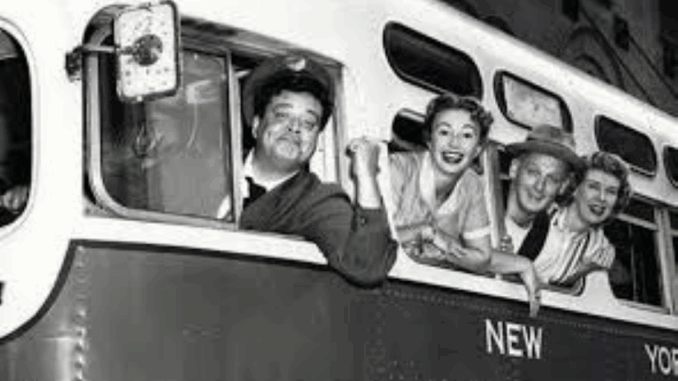
How the 1970s Revivals Became a Sentimental Farewell to Television’s Favorite Dreamer
By the mid-1970s, American television had changed dramatically. The days of live studio laughter and black-and-white sets were long gone, replaced by edgy social commentary, color saturation, and a growing appetite for realism. Yet for Jackie Gleason — the man who had once ruled Friday nights as Ralph Kramden, the blustering Brooklyn bus driver with a heart of gold — there was one world he could never fully leave behind: The Honeymooners.
Two decades after the “Classic 39” episodes had cemented the show’s legendary status, Gleason brought Ralph, Alice, and Ed Norton back once again. The result was a collection of made-for-TV movies and specials that aired between 1976 and 1978, collectively known as The Honeymooners Specials or The Second Honeymooners. For Gleason, these revivals were more than nostalgia — they were a personal goodbye to the characters and chemistry that had defined his career.
Back to the Roots — Without Losing the Color
While the 1960s Color Honeymooners episodes had been extravagant and musical, filled with orchestras and sweeping sets filmed in Miami Beach, the 1970s revival was quieter and more introspective. Gleason deliberately shifted gears. He stripped away the glitter and returned to a focus on character, dialogue, and the tender domestic chaos that had made the original so beloved.
Filmed in color but modestly produced, the specials looked like a bridge between two eras — modern television sheen mixed with the warmth of old Brooklyn. The sets were upgraded but still simple, the tone familiar yet tinged with reflection. This time, Ralph Kramden wasn’t chasing fame or fortune; he was confronting middle age, long marriages, and the bittersweet realization that life doesn’t always turn out like a dream.
The Old Gang Returns — Almost
To fans’ delight, Audrey Meadows and Art Carney both returned as Alice Kramden and Ed Norton. Their reunion with Gleason brought instant magic back to the screen. Decades after their first performances, the trio still moved in perfect rhythm — Carney’s rubber-limbed antics, Meadows’ cutting wit, and Gleason’s volcanic bluster all clicked as naturally as ever.
However, Joyce Randolph, the original Trixie, once again did not return. In her place was Jane Kean, who had already appeared as Trixie in the 1960s musical versions. Kean’s portrayal was softer and more effervescent, reflecting how comedy itself had evolved in the era of The Mary Tyler Moore Show and Happy Days. Her chemistry with Carney’s Norton gave the specials a playful, modern edge without losing their nostalgic heart.
Stories of Age, Love, and Everyday Life
Unlike the far-flung fantasy plots of the 1960s revivals, the Honeymooners Specials brought the story back home — literally. The couples were older now, navigating life’s quieter chapters. Plots revolved around anniversary celebrations, Ralph’s attempts at self-improvement, Norton’s harebrained inventions, and the tender humor of long-term marriage.
In one memorable special, Ralph and Alice look back on their years together, their dreams both fulfilled and unfulfilled. The laughter is still there, but so is a sense of poignancy. Beneath the punchlines lies a quiet awareness of time’s passage — a recognition that the once-young dreamers of the 1950s had grown older, wiser, and perhaps a little softer.
That maturity gave the specials emotional depth. Gleason, who was himself entering his sixties, infused Ralph with more vulnerability than before. His outbursts felt less like pure comedy and more like the frustrations of a man confronting the limits of his ambitions. Yet, true to form, he never stopped dreaming — and that was the key to his enduring charm.
Critical Response: A Gentle Goodbye

When the Honeymooners Specials premiered, critical reactions were mixed but affectionate. Television in the 1970s was dominated by bold, socially conscious sitcoms like All in the Family, MASH*, and The Mary Tyler Moore Show — programs that tackled politics, war, and feminism head-on. By comparison, The Honeymooners Specials seemed quaint, even anachronistic.
But for many viewers, that was exactly the appeal. In an age of cynicism and rapid change, seeing Ralph and Alice again felt like coming home. The chemistry between Gleason and Carney was still electric, and their timing, honed through decades of collaboration, remained a masterclass in comic performance.
For longtime fans, these specials weren’t about innovation or reinvention — they were about reunion. Gleason wasn’t trying to compete with the new generation of television. He was saying farewell in the only way he knew how: with laughter, warmth, and a touch of sentimentality.
The Legacy of a Lifelong Dreamer
By the late 1970s, Gleason had largely withdrawn from regular television work. His health was declining, and his interests had turned toward music and semi-retirement in Florida. Yet before stepping off the stage, he wanted to ensure that Ralph Kramden’s world — his greatest creation — received one final curtain call.
The Honeymooners Specials provided exactly that. They reminded audiences that comedy didn’t need flash or shock value to resonate. All it needed was a dreamer, a loyal friend, a patient wife, and a small Brooklyn apartment filled with big hopes.
Today, those 1970s specials may not hold the same cultural weight as the “Classic 39,” but they complete The Honeymooners story in a deeply human way. They show Ralph, Alice, and Norton not as caricatures, but as aging companions who grew up alongside the audience that loved them.
For Jackie Gleason, the return to Brooklyn was more than a revival — it was a full-circle moment. It was his chance to laugh one last time, to remind the world that no matter how many times life knocks you down, there’s always a dream worth chasing.
And in that final dream — shared by millions of viewers who still remember the glow of those sets and the sound of Gleason’s booming voice — The Honeymooners truly lived on.
